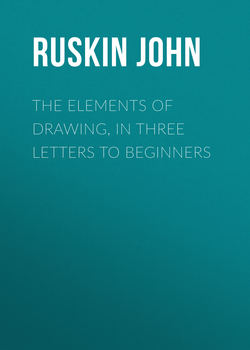Читать книгу The Elements of Drawing, in Three Letters to Beginners - Ruskin John - Страница 10
THE ELEMENTS OF DRAWING
LETTER I.
ON FIRST PRACTICE
EXERCISE VI
Оглавление20. Choose any tree that you think pretty, which is nearly bare of leaves, and which you can see against the sky, or against a pale wall, or other light ground: it must not be against strong light, or you will find the looking at it hurt your eyes; nor must it be in sunshine, or you will be puzzled by the lights on the boughs. But the tree must be in shade; and the sky blue, or gray, or dull white. A wholly gray or rainy day is the best for this practice.
21. You will see that all the boughs of the tree are dark against the sky. Consider them as so many dark rivers, to be laid down in a map with absolute accuracy; and, without the least thought about the roundness of the stems, map them all out in flat shade, scrawling them in with pencil, just as you did the limbs of your letters; then correct and alter them, rubbing out and out again, never minding how much your paper is dirtied (only not destroying its surface), until every bough is exactly, or as near as your utmost power can bring it, right in curvature and in thickness. Look at the white interstices between them with as much scrupulousness as if they were little estates which you had to survey, and draw maps of, for some important lawsuit, involving heavy penalties if you cut the least bit of a corner off any of them, or gave the hedge anywhere too deep a curve; and try continually to fancy the whole tree nothing but a flat ramification on a white ground. Do not take any trouble about the little twigs, which look like a confused network or mist; leave them all out,8 drawing only the main branches as far as you can see them distinctly, your object at present being not to draw a tree, but to learn how to do so. When you have got the thing as nearly right as you can,—and it is better to make one good study, than twenty left unnecessarily inaccurate,—take your pen, and put a fine outline to all the boughs, as you did to your letter, taking care, as far as possible, to put the outline within the edge of the shade, so as not to make the boughs thicker: the main use of the outline is to affirm the whole more clearly; to do away with little accidental roughnesses and excrescences, and especially to mark where boughs cross, or come in front of each other, as at such points their arrangement in this kind of sketch is unintelligible without the outline. It may perfectly well happen that in Nature it should be less distinct than your outline will make it; but it is better in this kind of sketch to mark the facts clearly. The temptation is always to be slovenly and careless, and the outline is like a bridle, and forces our indolence into attention and precision. The outline should be about the thickness of that in Fig. 4, which represents the ramification of a small stone pine, only I have not endeavored to represent the pencil shading within the outline, as I could not easily express it in a wood-cut; and you have nothing to do at present with the indication of foliage above, of which in another place. You may also draw your trees as much larger than this figure as you like; only, however large they may be, keep the outline as delicate, and draw the branches far enough into their outer sprays to give quite as slender ramification as you have in this figure, otherwise you do not get good enough practice out of them.
Fig. 4.
22. You cannot do too many studies of this kind: every one will give you some new notion about trees. But when you are tired of tree boughs, take any forms whatever which are drawn in flat color, one upon another; as patterns on any kind of cloth, or flat china (tiles, for instance), executed in two colors only; and practice drawing them of the right shape and size by the eye, and filling them in with shade of the depth required.
In doing this, you will first have to meet the difficulty of representing depth of color by depth of shade. Thus a pattern of ultramarine blue will have to be represented by a darker tint of gray than a pattern of yellow.
23. And now it is both time for you to begin to learn the mechanical use of the brush; and necessary for you to do so in order to provide yourself with the gradated scale of color which you will want. If you can, by any means, get acquainted with any ordinary skillful water-color painter, and prevail on him to show you how to lay on tints with a brush, by all means do so; not that you are yet, nor for a long while yet, to begin to color, but because the brush is often more convenient than the pencil for laying on masses or tints of shade, and the sooner you know how to manage it as an instrument the better. If, however, you have no opportunity of seeing how water-color is laid on by a workman of any kind, the following directions will help you:—
8
Or, if you feel able to do so, scratch them in with confused quick touches, indicating the general shape of the cloud or mist of twigs round the main branches; but do not take much trouble about them.
